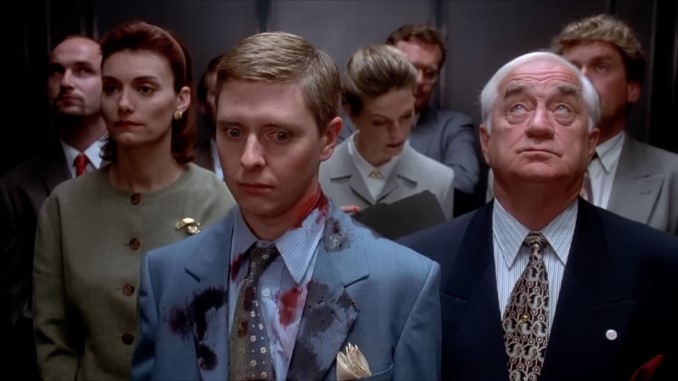Hear Me Out: The Wrong Guy
Subscriber Exclusive

The 1997 black comedy The Wrong Guy, served up by a veritable smorgasbord of Canadian comedic masterminds (from director David Steinberg to star Dave Foley of Kids in the Hall fame to even a cameo from the Barenaked Ladies as singing doo-wop policemen), is just about the definition of underground these days. Due to a series of unfortunate events mid-production, the film never even got a theatrical release in America, and was instead relegated to wasting away in the straight-to-DVD ether for all eternity—which is an unbelievable shame. Its failure was practically the death knell for many of the film’s creators, especially Foley himself, which is particularly devastating considering it was intended to do the exact opposite. There is most certainly a world in which The Wrong Guy got its proper due—at the very least becoming a cult hit—and Foley and co. were propelled into the world of so-dumb-it’s-smart comedy, set to have illustrious careers. There’s even a world in which the film broke into the mainstream zeitgeist as a beloved Jim Carrey caper (who apparently saw the script and wanted to star, an offer the film’s creators ended up turning down, as “the whole reason behind us writing it was to do it for ourselves”). Sadly, we seem to live in the worst possible timeline, and The Wrong Guy remains almost entirely unknown.
This is not to say we’re talking about a perfect movie; it lags a tad in its third act, and some of its gags fall somewhat flat or fail to hold up as well 20 odd years down the line. For instance, a recurring bit wherein Foley’s character gets mistaken for a woman gets a bit old, and a very ’90s joke about a pink-loving, Bronski-Beat-listening brother definitely being straight doesn’t land that great anymore. But there are myriad films that have much worse issues and yet have rocketed into the echelon of silly evergreen comfort movies anyways—and those don’t have half the charm of this Canadian romp. The Wrong Guy might not be Citizen Kane, but it’s far too good to languish in insignificance, unavailable on every streaming platform and only watchable via YouTube rip (plus side: that means it’s free!).
How funny you’ll find The Wrong Guy is probably directly proportional to how much mileage you think you’d get out of its aggressively silly premise: It’s The Fugitive, if the only person who thought Harrison Ford was wanted for murder was Harrison Ford himself. In other words, if he was dramatically on the lam for quite literally no reason … and also if he was incredibly bad at it.
After a surprisingly great animated credit sequence, we open on Dave Foley’s incomprehensibly dim business executive Nelson Hibbert very publicly threatening his boss upon being passed over for a promotion (he even proposed to his boss’ daughter for this—but, to his dismay, his coworker had married the boss’ other, favorite daughter). Upon stomping over to the big man’s office to give him another piece of his mind, Hibbert finds little more than a vacant stare and (gasp!) a knife in his boss’ neck waiting for him. What follows is about a five-minute extended bit that serves as an antithesis to How to Get Away With Murder; it’s essentially a tutorial on How (Not) to Get Away With a Murder (You Did Not Commit). Foley’s uniquely rubbery and entirely committed physicality is at full effect here: he shrieks at inhuman decibels, overtly panicking, as he runs around and pulls the knife out of his boss’ neck (??), shrieks some more upon realizing what he did, tries to put it back in the neck (???), can’t bring himself to do it, shrieks even more, and eventually runs out of the room into the crowded hallway, still shrieking, now covered in comically fake Kool Aid colored blood and, even worse, brandishing the murder weapon (????). So yeah, I do understand why he assumed the world thought him to be the murderer. The problem, though, is that they didn’t—and yet Hibbert begins a trek to Mexico anyways, believing it to be inevitable. “I don’t care which direction [I’m going],” he dramatically tells a bus driver, “I just need to get to Mexico,” seemingly unaware that that is, in fact, a direction. Unbeknownst to him (and at first, the real killer), there were active surveillance cameras rolling the entire time, and the killer (who goes unnamed throughout the film and is played with stoic suaveness by The Umbrella Academy’s Colm Feore) was witnessed red-handed—albeit not as literally red-handed as the blood-drenched Hibbert. Furious at his faulty information, the overly competent killer (as the cops continuously remark in awe, the man pulled himself into an air duct to escape, which has never been seen before nor since) begins to make his way to the border, where a Swiss passport will be waiting for him. Strange, though, that this little blonde man keeps popping up everywhere he goes. The killer deduces that his shadow must be a super spy who caught onto him, and curses that he’s met his match. Spoiler: it’s just Hibbert, and he has no idea who Feore even is, nor is he even aware of his existence.
-

-

-

-

-

-

-

-

-

-

-

-

-

-

-

-

-

-

-

-

-

-

-

-

-

-

-

-

-

-

-

-

-

-

-

-

-

-

-

-








































